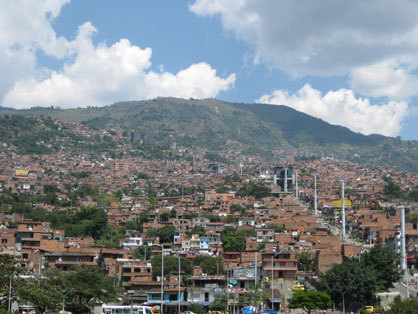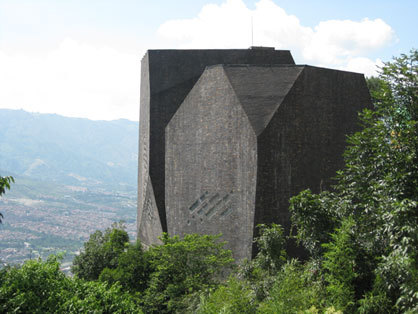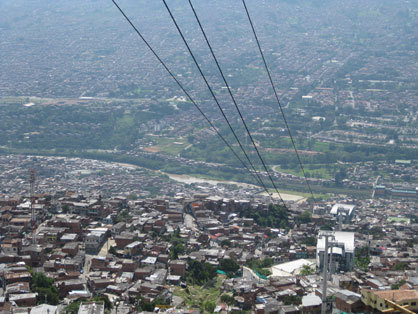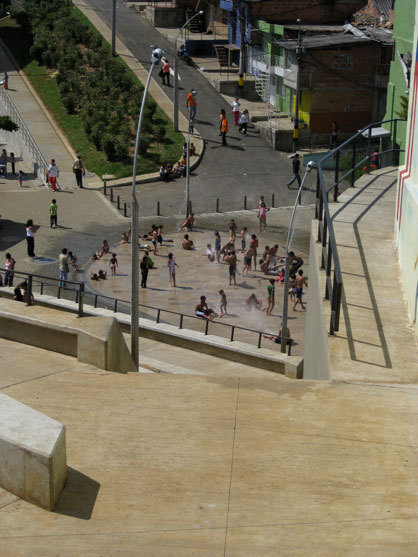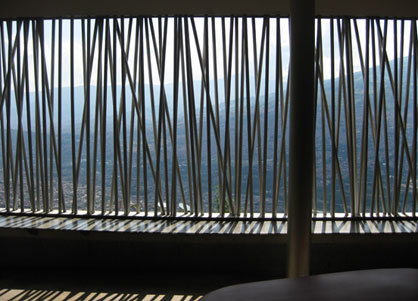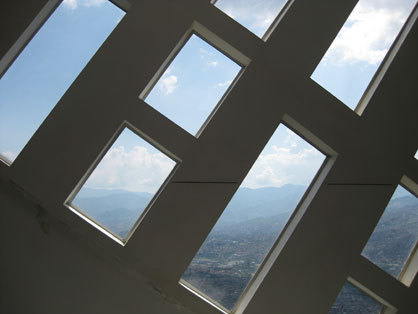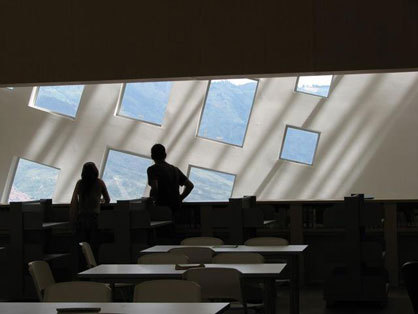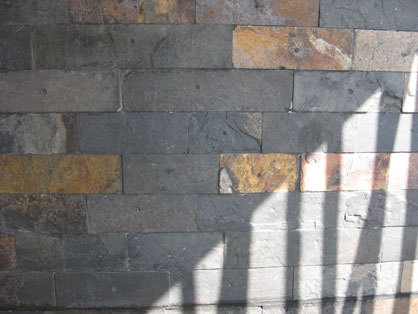Parque Biblioteca España
Text by NoéMie Schwaller
Zürich, Switzerland
10.08.09
In areas of urban underprivilege and unrest, libraries can improve the quality of life. Based on the urban development model of Chicago, a library park has now sprung up in Medellín, the second-biggest city in Columbia.
The path is steep, demanding and zigzagging, the heat is unbearable, but even from far off you have the reward of seeing a proud, massive, rectangular building which radiates an atmosphere of calm, towering like a fortress over the hilly landscape.
Parque Biblioteca España. If not mentioned otherwise Photos: NoéMie Schwaller
In areas of urban underprivilege and unrest, libraries can improve the quality of life. Based on the urban development model of Chicago, a library park has now sprung up in Medellín, the second-biggest city in Columbia.
The cable car is part of Fajardos' efforts to improve the infrastructure of Medellín.
With its growing textile and mechanical engineering industries, the capital of the Antioquia district in the upper valley of the Porce has developed into an economic centre since the middle of the twentieth century. In contrast the development of the city itself has brought tremendous challenges, with a problematic structure created by internal migration, population growth and the shanty towns which have sprung up.
The view of Medellín, at one time the world's most dangerous city, from Santo Domingo Savio
Since his election as mayor in 2003, Sergio Fajardo has been trying to counteract this process by means of integrative urban development. In the city's worst slums he has commissioned prestigious architects to design public institutions with a focus on education, public spaces and transport. The strategy is a simple one: investment in civil commitment instead of in public security.
The three black blocks of Santo Domingo Savio stand out like a challenging manifestation of culture in a location of hope and uncertainty. Photo: reddebibliotecas.org.co
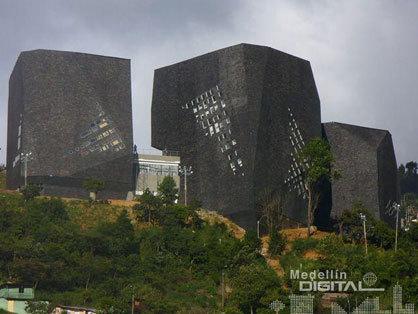
The three black blocks of Santo Domingo Savio stand out like a challenging manifestation of culture in a location of hope and uncertainty. Photo: reddebibliotecas.org.co
×Five libraries make up the library park and they are all located in socio-political problem areas. "Our most beautiful buildings", says Fajardo, "must be in our poorest areas." The facts speak for themselves: since 1991 the murder rate in this city with its population of two million has fallen by a factor of 13.
Kids playing in front of the Parque Biblioteca España in Santo Domingo Savio
The local transport system set up in the Medellín area is the Metro de Medellín, Columbia's only overhead railway line. It was established less as a means of mass transport for the city's working classes and more as an important cultural axis which integrates minorities and undermines the border between rich and poor. It floats above the slum of Santo Domingo Savio with its population of 170'000. As it leads directly to the Parque Biblioteca España, it is especially important to the lowest strata of the population, in that many of them live up on the hill and, after finishing work in the city centre, used to be faced with a two-hour climb up the steep slope. Built by Giancarlo Mazzanti in 2007, the Parque Biblioteca España contains a library, an auditorum, internet access, a day-care centre and an art gallery.
The three black blocks of Santo Domingo Savio stand out like a challenging manifestation of culture in a location of hope and uncertainty. The five-storey interior forms an area of brightness, as if it were flooded by the light of the knowledge collected here and by fresh air. The blocks are connected with one another in an organic way. Visitors enter the reading room with its more than 12,000 volumes through an angular entrance. Forty computers with internet connection are available for the use of readers.
The composition of the windows allows exciting views.
On a number of levels of the right-hand block there are rooms for artistic development and sporting activities, while the basement level houses the administrative offices. To the left of the entrance the well-equipped auditorium, which is used for readings, film shows, theatre groups and concerts, represents an oasis of peace. It is also the place where the community discusses the solutions to its problems.
In spite of reconstruction work, many parts of the city are still notorious for drugs and violence.

In spite of reconstruction work, many parts of the city are still notorious for drugs and violence.
×These three sections – reading room, recreational area, auditorium – form the basic structure of all five libraries. They differ mainly in their architecture, which elsewhere features pavilions arranged in terrace format. In Comuna 13, the area of the city with the highest levels of violent crime, the library also contains a fourth element, the 'Centre for the development of work opportunities' (CEDEZO), which provides practical support for economic self-help activities.
In the reading room one can find over 12'000 books. Photo: reddebibliotecas.org.co
It is still an open question whether the Métro de Medellín really does serve the city's poorer population groups as a means of transport, in that not everybody can afford to pay for the tickets. One thing is sure, however, and that is that since the metro began operations there are fewer paramilitary forces to be seen in Santo Domingo Savio.
Thanks to the courageous reform policies of Sergio Fajardo the city of Medellín, a former major centre of terror, has been regenerated into one of Columbia's most important industrial and cultural centres. The mayor believes in architecture and the contribution which this investment in education and public facilities can make to the development of the skills which the poor need if they are to compete with the better educated social classes.


